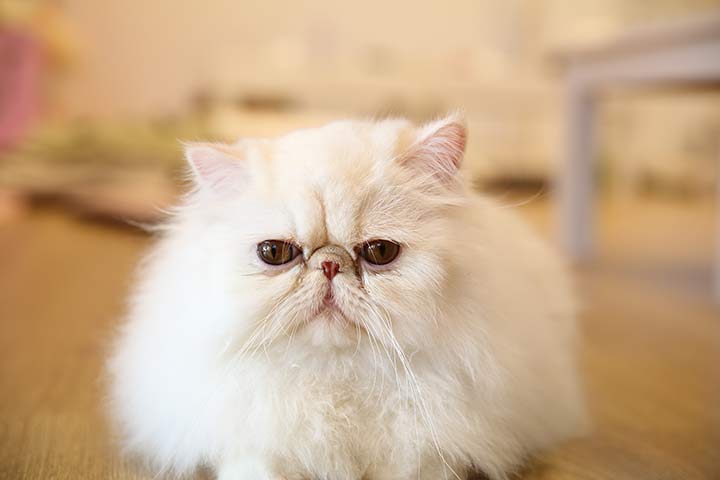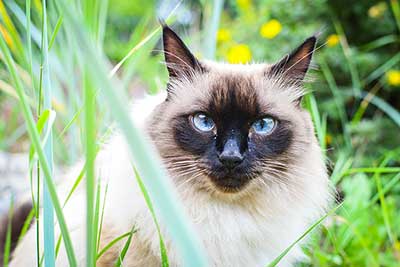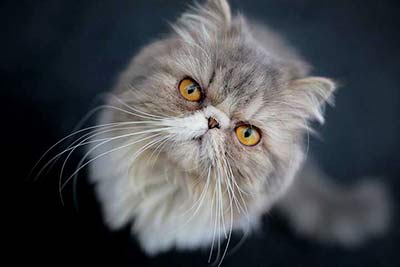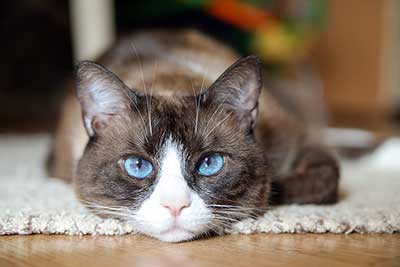Persian
Persian Cat Breed Profile
| Weight | 7.7-22 lbs (3.5-10 kg) |
| Origin | Iran |
| Color | All colors; multi-colored |
| Fur | Long, dense, fine |
| Lifespan | 8-14 years |
| Personality | Intelligent, quiet, affectionate, calm |
| Energy | |
| Playful | |
| Independent | |
| Meowing | |
| Shedding |

Breed Characteristics
You can spot a Persian right away thanks to its lovely long coat, short nose and special character. They move and behave so elegantly and gracefully that you constantly have the feeling that you should address them as “Your Majesty”.
Personality and Temperament
What type of character does the Persian have? They’re easy-going, reserved, calm, loving, playful and cuddly. They give all their love to their family but are very wary of strangers.
Ideally, a Persian cat would like to watch over its kingdom from a comfy cushion. Or even better, on a lap, so they can be petted as they do so. These cats won’t climb up your drapes or jump onto the kitchen table, even when left alone. That just wouldn’t be appropriate for a cat of this ranking! They prefer to spend most of their time on the sofa, a chair, windowsill or even the floor.
The Persian isn’t a diva that constantly expects and demands its owner’s full attention. But they’ll happily bask in adoration if that’s on the cards. They can be a little fussy though: when it comes to food, they can be very choosy indeed!

Keeping Them Happy
Persians are very sensitive to noise and don’t like change. But they’re not known for being especially quick to scratch or hiss. After all, such a noble cat can’t be seen to be so quick-tempered.
Persians are better at dealing with long periods of time alone than other cat breeds. They’ll just take a long nap. They’re also fine with being house cats, as they don’t have such a strong instinct to exercise as other cat breeds.
Persian cats also need extra care and attention when it comes to grooming, and expect their “staff” to have plenty of time and patience! Their fur should be brushed every other day to prevent knots and matting. They also have to be bathed frequently as their fur will otherwise get dirty and things will get caught in it, and it can start to smell.

Pros and Cons
Pros
- Exceptionally soft fur
- Exotic looks
- Loving
- Easy going
- People oriented
- Doesn't need a lot of exercise
- Gets along well in an apartment
- Loves being a lap dog
Cons
- Sheds a lot
- Requires extensive grooming
- Not very active
- Not very playful
- Learns slowly (or just doesn't want to ;))
Records
Two Himalayan-Persian cats have already made it into the Guinness Book of World Records: 1. Colonel Meow has held the record for the longest fur, at 9 inches (22.87 cm), in the world since 2014. 2. Tinker Toy has been recorded as the smallest cat in the world since 1990 as he was measured at just 2.75 inches (7 cm) tall at the shoulder and 7.5 inches (19 cm) long.
Popular Cat Breed
Persian cats aren’t just very popular in Germany. In the USA, the Cat Fanciers' Association (they keep track of all cats registered each year) has ranked the Persian cat in the top 5 for the last five years in a row. The breed also took 5th place in 2022. In England, this breed was at 1st place for a long time. But it has “fallen out of fashion” since 2001. But who knows what will happen in the next 10 years? Maybe the tables will turn.

Appearance
The Persian is a medium to large cat. It can have all kinds of fur colors and markings e.g. tortoiseshell. It has a round head with full cheeks, big eyes, a distinctive short nose and small ears. Its legs are short with large, round paws.

History
For a long time, people thought that the Persian cat came from former Persia, which is now Iran. But now, we’re not so sure. They could date back to Russian house cats. One thing’s for sure: the Persian is a very old cat breed. The first Persian cats appeared in Europe in the mid-17th century.
Cruel Breeding
Persians are considered as an animal cruelty. They were bred to have a flat face with a particularly short nose. This is mainly known in dog breeding - from the French bulldog, the English bulldog and the pug. So. Why is a short nose a problem? It results in severe respiratory problems. In addition, the lacrimal canal in the eyes are narrowed. This is why eye infections happen on a regular basis. In addition, the teeth are often misaligned because the upper jaw is shortened. Around 38% of this breed worldwide suffer from a kidney disease.
Persian cats are wonderful cats. You have to decide for yourself whether it is right to buy one, although knowing how much it suffers. Everyone who buys a kitten encourages breeders to keep going. After all, the buyers determine the demand. Instead, you could adopt one from an animal shelter. With the right care, you can give your furry pet a good life. You can decide to choose a different breed, too. There are so many beautiful ones!
Fun Facts
The Exotic Shorthair is a cross between the Persian and American Shorthair.
Comparable Breeds



























